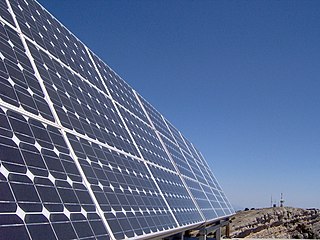Many nations have installed significant solar power capacity into their electrical grids to supplement or provide an alternative to conventional energy sources. Solar power plants use one of two technologies:

Solar power in Romania had an installed capacity of 1,374 megawatt (MW) as of the end of 2017. The country had in 2007 an installed capacity of 0.30 MW, which increased to 3.5 MW by the end of 2011, and to 6.5 MW by the end of 2012. However, the record year of 2013 was an exception, and new installation fell back from 1,100 MW to a moderate level of 69 MW in 2014.

Solar power in California includes utility-scale solar power plants as well as local distributed generation, mostly from rooftop photovoltaics. It has been growing rapidly because of high insolation, community support, declining solar costs, and a Renewable Portfolio Standard which requires that 33% of California's electricity come from renewable resources by 2020, and 50% by 2030. Much of this is expected to come from solar power via photovoltaic facilities or solar thermal power facilities.

Pakistan has some of the highest values of insolation in the world, with eight to nine hours of sunshine per day, ideal climatic conditions for solar power generation. However, the country has been slow to adopt the technology.
Huanghe Hydropower's Golmud Solar park is a 200 megawatt (MW) photovoltaic power station located in Golmud, Qinghai Province, China. Construction began in August 2009, and it was commissioned on October 29, 2011. 80 MW was provided by Yingli. The project won the 2012 China Quality Power Project Award. Output is expected to be 317 GWh per year.
The Gabardan Solar Park is a 67.5 megawatt (MW) photovoltaic power station in France. It has about 872,300 thin-film PV panels made by First Solar, and incorporates a 2 MW pilot plant using 11,100 solar trackers.

As of the end of 2014, solar power in Austria amounted to 766 megawatt (MW) of cumulative photovoltaic (PV) capacity, of which more than three quarters were installed within the last four years. Solar PV generated 766 gigawatt-hours, or about 1.4% of the country's final electricity consumption. As with most other European countries, 99.5 percent of all solar power systems are connected to the electrical grid. The nation's installed PV capacity by inhabitant stood at 91 watts, still below the European Union's 2014-average of 172 watts.
The Fürstenwalde Solar Park is a photovoltaic power station in Fürstenwalde, Germany. It has a capacity of 39.64 megawatt (MW) and an annual output of 36.5 GWh. The solar park was developed by the company Solarhybrid and built by conecon using 62,832 225-watt and 110,880 230-watt solar panels, both manufactured by Suntech.
The Solarpark Heideblick is a photovoltaic power station in Heideblick, Germany. It has a capacity of 27.5 megawatts (MW). The solar park was developed and built by Enerparc.
Reckahn Solar Park is a photovoltaic power station in Reckahn, Southwest of Berlin, Germany. It has a capacity of 37.7 megawatt (MW) and was constructed in three phases. Reckahn I was 22.661 MW covering 56 hectares and was built by Beck Energy GmbH (Belectric) using 292,000 First Solar thin-film CdTe-panels, and was expected to produce about 22 gigawatt-hours per year. Reckahn II added 13.3 MW, using 172,000 modules on a 35 hectares site. Reckahn III, completed in 2011, added 1.8 MW, bringing the total to 37.7 MW. The FIT is 21.1 Euro cents per kilowatt-hour.

Solar power in Idaho comprises 478 MW. Rooftops can provide 26.4% of all electricity used in Idaho from 4,700 MW of solar panels. The low average cost of hydro-electricity makes Idaho one of the last states in the country to reach grid parity. However, in January 2015, there were 461 MW of solar power contracted to be built in Idaho which would give the state more solar capacity per capita than any other state.
The Catalina Solar Project is a 143.2 megawatt (MW) photovoltaic power station located near Bakersfield, Kern County, California, owned by enXco, an EDF Énergies Nouvelles Company. It covers area of 445 hectares.
Neuhardenberg Solar Park is a 145-megawatt (MW) photovoltaic power plant, and was Europe's largest solar power station, located at the former Neuhardenberg military airport in Brandenburg, Germany.

The Jännersdorf Solar Park is a photovoltaic power station in Prignitz, Germany. It has a capacity of 40.5 megawatts (MW) and an annual output of 38 GWh. The solar park was developed and built by Parabel AG.
Northern Chile has the highest solar incidence in the world. In October 2015 Chile's Ministry of Energy announced its "Roadmap to 2050: A Sustainable and Inclusive Strategy", which plans for 19% of the country's electricity to be from solar energy, 23% wind power and 29% hydroelectric power.
The CIAL Solar Power Project is a 40 megawatt (MW) photovoltaic power station built at COK airport, India, by the company Cochin International Airport Limited (CIAL). Cochin International Airport became the first fully solar powered airport in the world with the commissioning the plant.











